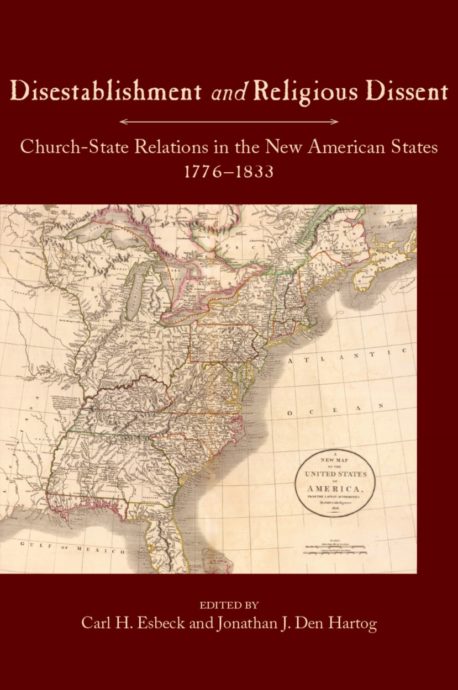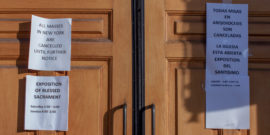The Complicated History of Disestablishment
Scholars and popular authors alike regularly assert that nine of America’s first thirteen states had established churches. But, as one writer puts it, the “framers of the Bill of Rights hoped that the First Amendment would encourage other states to follow Virginia’s example and establish the complete separation between religious and civil authorities.” When Massachusetts disestablished its state church in 1833, so the story goes, this noble project was complete.
While common, this account is profoundly misleading. Those who tell it neglect to define “establishment,” ignore pre-English colonial establishments, and do not consider states formed after the Constitution was ratified. Most significantly for the Supreme Court’s Establishment Clause jurisprudence, it exaggerates the influence of Thomas Jefferson, James Madison, and debates about church-state relations in Virginia.
Disestablishment and Religious Dissent: Church-State Relations in the New American States, 1776–1833, edited by Carl H. Esbeck and Jonathan J. Den Hartog, does much to set the record straight. The editors recruited fine scholars to write chapters on the religious establishments and debates over disestablishment in more than 20 states. These include the original 13 states, as well as Vermont, Kentucky, Tennessee, Ohio, Maine, Florida, and the Louisiana and Missouri Territories.
One of this volume’s many virtues is that it is a handy resource for anyone interested in church-state relations in any of these states. Each chapter is solidly grounded in the primary sources and engages in the most recent secondary accounts of church-state relations in them. In some instances, e.g. Pennsylvania, Massachusetts, and Virginia, this is well-trodden ground (even so, the chapters on these states are excellent). But for other states, the chapters offer the most up-to-date, concise, and scholarly treatment of their subjects.
Because it is such a useful resource, every college and university library should own a copy of Disestablishment and Religious Dissent. But it also should be read by anyone who works on religious liberty or church-state relations in early America. Unlike many scholars, Esbeck and Den Hartog carefully define important terms, starting with “establishment” itself. They contend that establishments include one or more of the following features:
- Government financial support of the state church: assessments to pay ministers and rents from glebe lands.
- Government control over the creeds, order of worship, polity, and clerical appointments of the state church. . . .
- Mandatory attendance at worship services in the state church, prohibitions on church services by others, and required licensure to open a meeting house for nonconformists.
- Use of the state church to record births, marriages, and deaths; to perform all marriages and funerals; and to administer tax revenues for the care of the poor and widows. . . .
- Religious tests. Public office and voting rights confined to members of the state church or a broader test to include nonconformists.
This definition is similar to one offered by Michael W. McConnell in an influential 2003 article, but theirs is derived from the book’s 20 substantive chapters. It is worth emphasizing this nuanced definition because far too many scholars simplistically equate establishments with financial support for churches.
Esbeck and Den Hartog’s definition of “establishment” makes it difficult to offer neat, tidy dates for when states disestablished religion. For instance, many states retained religious tests for civic offices and prohibitions on ministers holding civic office well into the 19th century, and a few maintained them until they were declared to be unconstitutional in Torcaso v. Watkins (1961) and McDaniel v. Paty (1978).
The Virginia General Assembly, on the other hand, banned religious tests for civic offices when it passed Thomas Jefferson’s Statute for Religious Liberty in 1786. But it did not repeal a law “whereby the general assembly made ecclesiastical decisions on behalf of the Episcopalian Church” until 1787. It is thus not unreasonable to conclude, contrary to many scholars and popular authors, that Virginia disestablished its state church in 1787 rather than 1786.
Even more interesting, Ohio’s 1802 constitution stated that “no man shall be compelled to attend, erect, or support any place of worship, or to maintain any ministry, against his consent,” and that the
laws shall be passed by the legislature which shall secure to each and every denomination of religious societies in each surveyed township, which now is or may hereafter be formed in the State, an equal participation, according to their number of adherents, of the profits arising from the land granted by Congress for the support of religion.
Acting upon this provision, the Ohio legislature passed laws directing revenue from “ministerial lands” to churches. These statutes were amended and revised, but they remained law until voters amended the state constitution in 1968.
Many of the book’s chapters discuss ways in which states continued to favor some denominations and religions over others well into the 19th century. But they also shed light on earlier religious establishments that are often neglected. For instance, Evan Haefeli observes that although Delaware is usually counted among the states that never had an establishment, it actually had several: the Swedish Lutheran Church when it was a Swedish colony, and later the Reformed Church when controlled by the Dutch.
Similarly, the authors of the chapters on Florida and the Louisiana and Missouri territories offer an interesting discussion of Roman Catholic establishments in areas that became multiple American states. It is striking to think that when the United States “acquired the Louisiana Territory in 1803, Roman Catholicism had been the established religion for more than one hundred years.” Indeed, a 1724 Royal Edict by the King of France “regarded non-Catholic religious assemblies as ‘illicit and seditious councils’ and prohibited them.”
Esbeck and Den Hartog’s introduction contains ten “findings” derived from the book’s substantive chapters. Among the most interesting is that:
Neither the U.S. Constitution of 1787-88 nor the First Amendment of 1789-91 contributed to the disestablishment process in the original thirteen states. The same is true in the three admitted states that were never federal territories: Vermont, Kentucky, and Maine.
Perhaps most significant, given the many authors and Supreme Court Justices who argue to the contrary, are their observations that “it cannot be said that the disestablishment story in any one state was more important than that of others” and that the “conventional view of Thomas Jefferson’s broad influence on the disestablishment process in the states has little support in the evidence reported by our chapter authors.” As I have argued on these pages, and more recently in Did America Have a Christian Founding?, there is simply no good historical reason to believe that the founders’ approach to church-state relations can be understood by careful study of Virginia’s disestablishment debates or Jefferson’s and Madison’s views.
Scholars and popular authors alike often prefer neat and tidy answers. Disestablishment and Religious Dissent makes it clear that no such answers exist when it comes to church-state relations in America’s first states. This collection is essential reading for anyone interested in an accurate account of these complicated matters.


